CNA252 Case Study: Clinical Reasoning and Care Plan for Asthma
VerifiedAdded on 2023/04/23
|9
|2219
|276
Case Study
AI Summary
This case study focuses on Kobi Monterey, a 25-year-old with a history of asthma, who experiences an acute asthma attack triggered by occupational exposure as a carpenter. The analysis involves collecting cues, interpreting data (normal vs. abnormal), relating cues to pathophysiology (occupational asthma, bronchospasm, cyanosis), and predicting potential outcomes if untreated (sleep deprivation, lung damage, psychological issues, respiratory failure). Key nursing problems identified include managing the asthma attack and treating lip cyanosis. The care plan prioritizes asthma attack management through supplemental oxygen administration, inhaled corticosteroids, beta-2 adrenergic agonists, and patient positioning in a semi-Fowler's position. The reflection component involves analyzing a video of a clinical skill performance, identifying strengths and weaknesses, and outlining actions to improve future practice, reinforcing professional responsibility and informing future learning. The assignment emphasizes the application of the clinical reasoning cycle in a practical healthcare scenario.
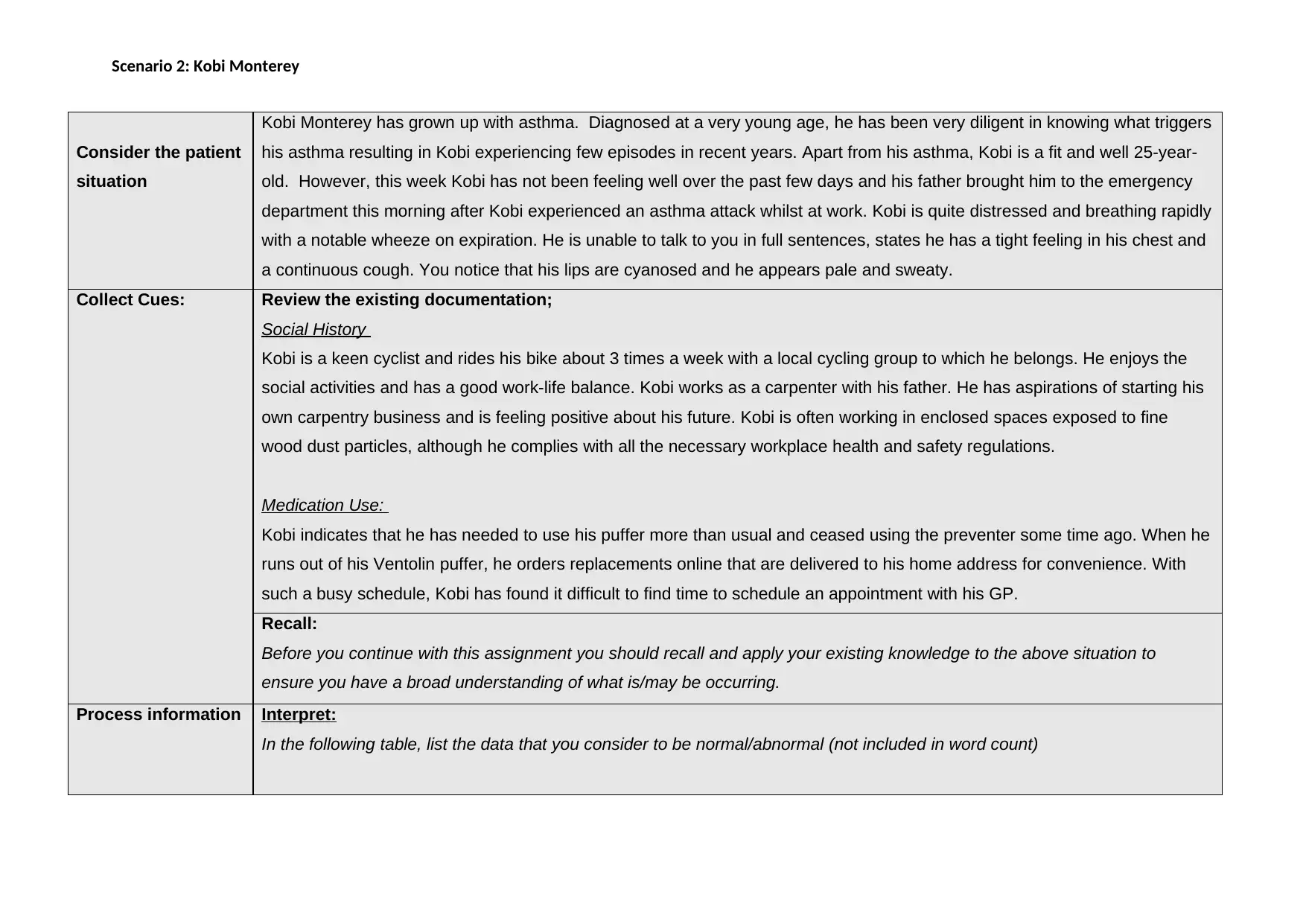
Scenario 2: Kobi Monterey
Consider the patient
situation
Kobi Monterey has grown up with asthma. Diagnosed at a very young age, he has been very diligent in knowing what triggers
his asthma resulting in Kobi experiencing few episodes in recent years. Apart from his asthma, Kobi is a fit and well 25-year-
old. However, this week Kobi has not been feeling well over the past few days and his father brought him to the emergency
department this morning after Kobi experienced an asthma attack whilst at work. Kobi is quite distressed and breathing rapidly
with a notable wheeze on expiration. He is unable to talk to you in full sentences, states he has a tight feeling in his chest and
a continuous cough. You notice that his lips are cyanosed and he appears pale and sweaty.
Collect Cues: Review the existing documentation;
Social History
Kobi is a keen cyclist and rides his bike about 3 times a week with a local cycling group to which he belongs. He enjoys the
social activities and has a good work-life balance. Kobi works as a carpenter with his father. He has aspirations of starting his
own carpentry business and is feeling positive about his future. Kobi is often working in enclosed spaces exposed to fine
wood dust particles, although he complies with all the necessary workplace health and safety regulations.
Medication Use:
Kobi indicates that he has needed to use his puffer more than usual and ceased using the preventer some time ago. When he
runs out of his Ventolin puffer, he orders replacements online that are delivered to his home address for convenience. With
such a busy schedule, Kobi has found it difficult to find time to schedule an appointment with his GP.
Recall:
Before you continue with this assignment you should recall and apply your existing knowledge to the above situation to
ensure you have a broad understanding of what is/may be occurring.
Process information Interpret:
In the following table, list the data that you consider to be normal/abnormal (not included in word count)
Consider the patient
situation
Kobi Monterey has grown up with asthma. Diagnosed at a very young age, he has been very diligent in knowing what triggers
his asthma resulting in Kobi experiencing few episodes in recent years. Apart from his asthma, Kobi is a fit and well 25-year-
old. However, this week Kobi has not been feeling well over the past few days and his father brought him to the emergency
department this morning after Kobi experienced an asthma attack whilst at work. Kobi is quite distressed and breathing rapidly
with a notable wheeze on expiration. He is unable to talk to you in full sentences, states he has a tight feeling in his chest and
a continuous cough. You notice that his lips are cyanosed and he appears pale and sweaty.
Collect Cues: Review the existing documentation;
Social History
Kobi is a keen cyclist and rides his bike about 3 times a week with a local cycling group to which he belongs. He enjoys the
social activities and has a good work-life balance. Kobi works as a carpenter with his father. He has aspirations of starting his
own carpentry business and is feeling positive about his future. Kobi is often working in enclosed spaces exposed to fine
wood dust particles, although he complies with all the necessary workplace health and safety regulations.
Medication Use:
Kobi indicates that he has needed to use his puffer more than usual and ceased using the preventer some time ago. When he
runs out of his Ventolin puffer, he orders replacements online that are delivered to his home address for convenience. With
such a busy schedule, Kobi has found it difficult to find time to schedule an appointment with his GP.
Recall:
Before you continue with this assignment you should recall and apply your existing knowledge to the above situation to
ensure you have a broad understanding of what is/may be occurring.
Process information Interpret:
In the following table, list the data that you consider to be normal/abnormal (not included in word count)
Paraphrase This Document
Need a fresh take? Get an instant paraphrase of this document with our AI Paraphraser
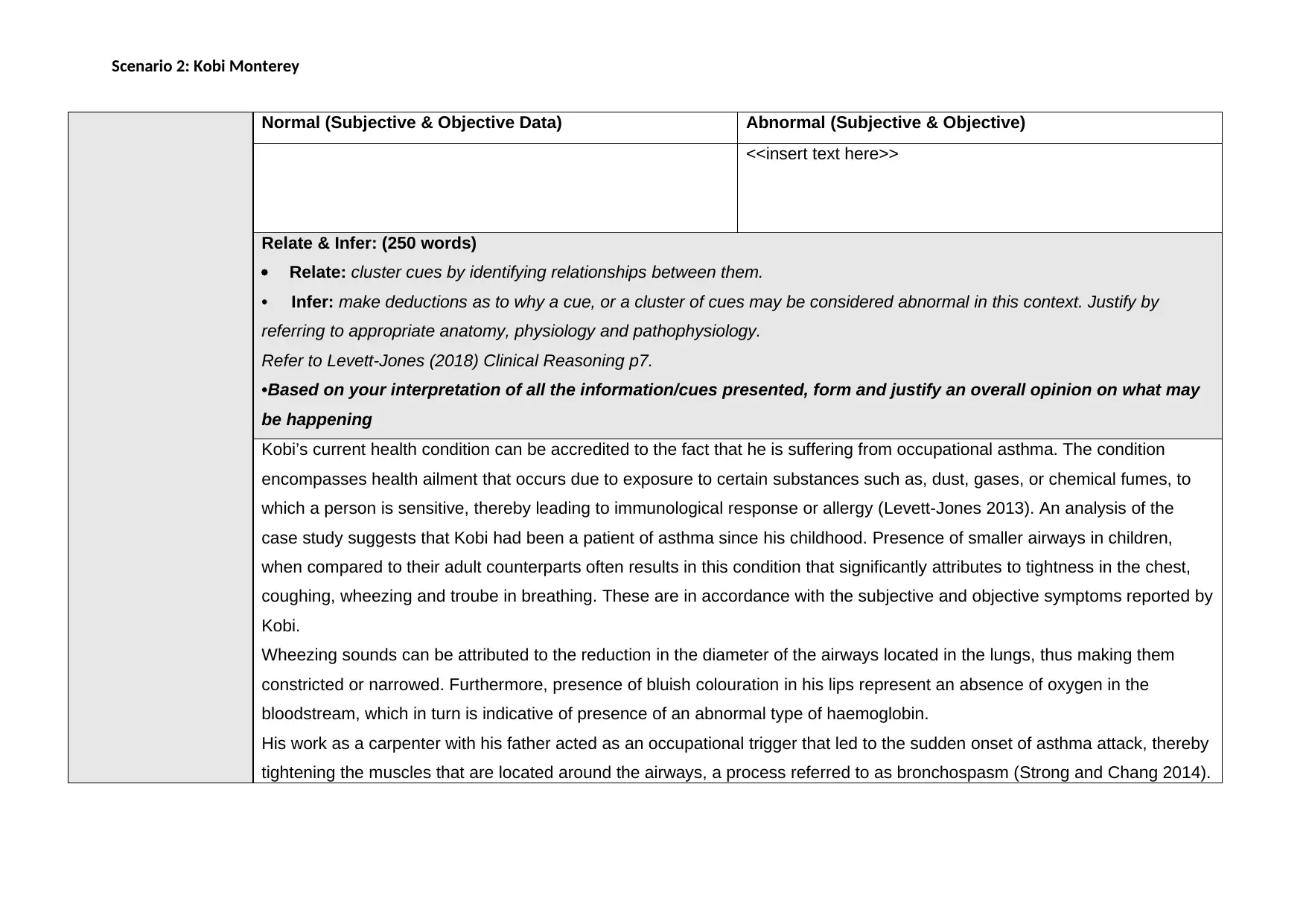
Scenario 2: Kobi Monterey
Normal (Subjective & Objective Data) Abnormal (Subjective & Objective)
<<insert text here>>
Relate & Infer: (250 words)
Relate: cluster cues by identifying relationships between them.
• Infer: make deductions as to why a cue, or a cluster of cues may be considered abnormal in this context. Justify by
referring to appropriate anatomy, physiology and pathophysiology.
Refer to Levett-Jones (2018) Clinical Reasoning p7.
•Based on your interpretation of all the information/cues presented, form and justify an overall opinion on what may
be happening
Kobi’s current health condition can be accredited to the fact that he is suffering from occupational asthma. The condition
encompasses health ailment that occurs due to exposure to certain substances such as, dust, gases, or chemical fumes, to
which a person is sensitive, thereby leading to immunological response or allergy (Levett-Jones 2013). An analysis of the
case study suggests that Kobi had been a patient of asthma since his childhood. Presence of smaller airways in children,
when compared to their adult counterparts often results in this condition that significantly attributes to tightness in the chest,
coughing, wheezing and troube in breathing. These are in accordance with the subjective and objective symptoms reported by
Kobi.
Wheezing sounds can be attributed to the reduction in the diameter of the airways located in the lungs, thus making them
constricted or narrowed. Furthermore, presence of bluish colouration in his lips represent an absence of oxygen in the
bloodstream, which in turn is indicative of presence of an abnormal type of haemoglobin.
His work as a carpenter with his father acted as an occupational trigger that led to the sudden onset of asthma attack, thereby
tightening the muscles that are located around the airways, a process referred to as bronchospasm (Strong and Chang 2014).
Normal (Subjective & Objective Data) Abnormal (Subjective & Objective)
<<insert text here>>
Relate & Infer: (250 words)
Relate: cluster cues by identifying relationships between them.
• Infer: make deductions as to why a cue, or a cluster of cues may be considered abnormal in this context. Justify by
referring to appropriate anatomy, physiology and pathophysiology.
Refer to Levett-Jones (2018) Clinical Reasoning p7.
•Based on your interpretation of all the information/cues presented, form and justify an overall opinion on what may
be happening
Kobi’s current health condition can be accredited to the fact that he is suffering from occupational asthma. The condition
encompasses health ailment that occurs due to exposure to certain substances such as, dust, gases, or chemical fumes, to
which a person is sensitive, thereby leading to immunological response or allergy (Levett-Jones 2013). An analysis of the
case study suggests that Kobi had been a patient of asthma since his childhood. Presence of smaller airways in children,
when compared to their adult counterparts often results in this condition that significantly attributes to tightness in the chest,
coughing, wheezing and troube in breathing. These are in accordance with the subjective and objective symptoms reported by
Kobi.
Wheezing sounds can be attributed to the reduction in the diameter of the airways located in the lungs, thus making them
constricted or narrowed. Furthermore, presence of bluish colouration in his lips represent an absence of oxygen in the
bloodstream, which in turn is indicative of presence of an abnormal type of haemoglobin.
His work as a carpenter with his father acted as an occupational trigger that led to the sudden onset of asthma attack, thereby
tightening the muscles that are located around the airways, a process referred to as bronchospasm (Strong and Chang 2014).
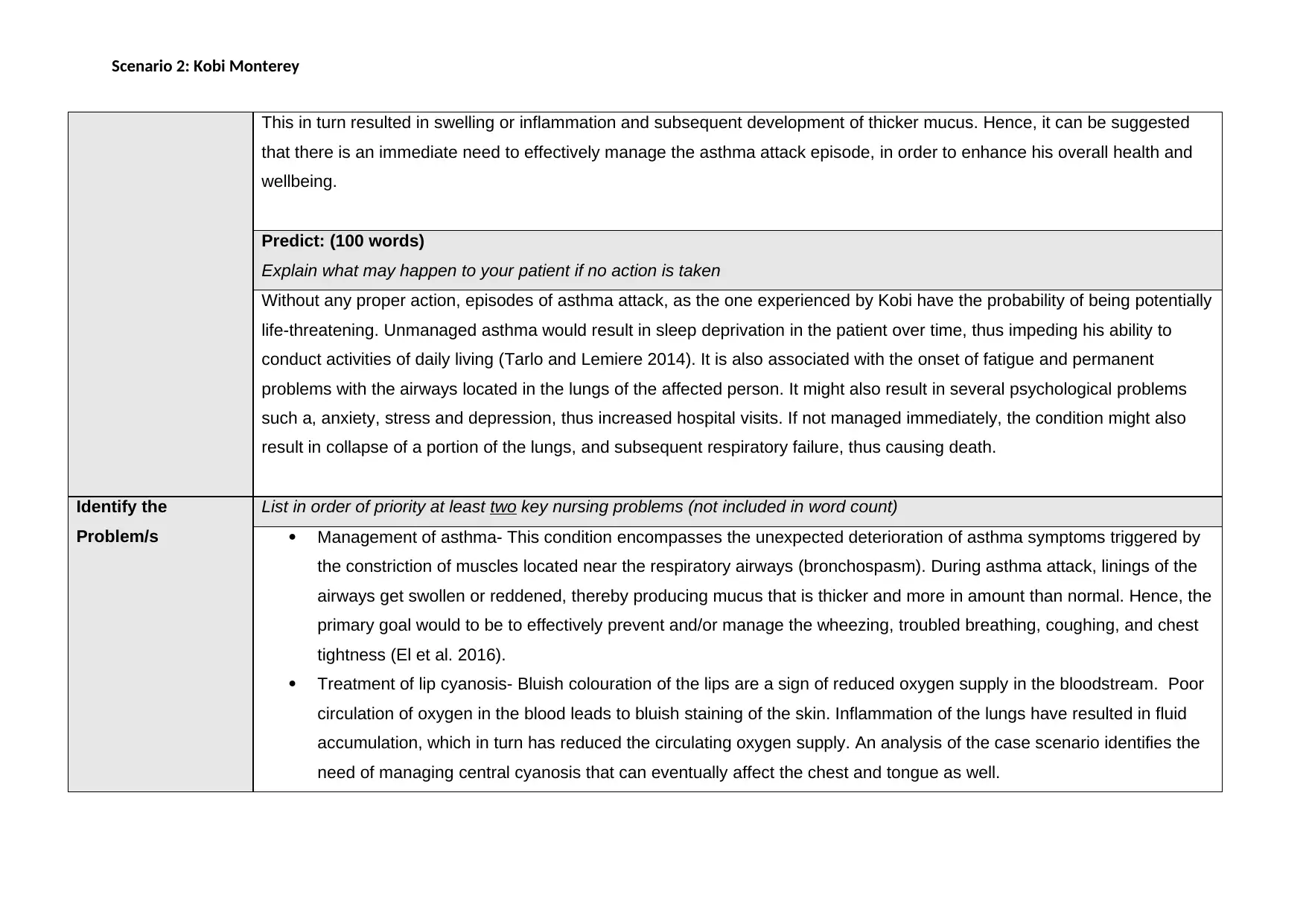
Scenario 2: Kobi Monterey
This in turn resulted in swelling or inflammation and subsequent development of thicker mucus. Hence, it can be suggested
that there is an immediate need to effectively manage the asthma attack episode, in order to enhance his overall health and
wellbeing.
Predict: (100 words)
Explain what may happen to your patient if no action is taken
Without any proper action, episodes of asthma attack, as the one experienced by Kobi have the probability of being potentially
life-threatening. Unmanaged asthma would result in sleep deprivation in the patient over time, thus impeding his ability to
conduct activities of daily living (Tarlo and Lemiere 2014). It is also associated with the onset of fatigue and permanent
problems with the airways located in the lungs of the affected person. It might also result in several psychological problems
such a, anxiety, stress and depression, thus increased hospital visits. If not managed immediately, the condition might also
result in collapse of a portion of the lungs, and subsequent respiratory failure, thus causing death.
Identify the
Problem/s
List in order of priority at least two key nursing problems (not included in word count)
Management of asthma- This condition encompasses the unexpected deterioration of asthma symptoms triggered by
the constriction of muscles located near the respiratory airways (bronchospasm). During asthma attack, linings of the
airways get swollen or reddened, thereby producing mucus that is thicker and more in amount than normal. Hence, the
primary goal would to be to effectively prevent and/or manage the wheezing, troubled breathing, coughing, and chest
tightness (El et al. 2016).
Treatment of lip cyanosis- Bluish colouration of the lips are a sign of reduced oxygen supply in the bloodstream. Poor
circulation of oxygen in the blood leads to bluish staining of the skin. Inflammation of the lungs have resulted in fluid
accumulation, which in turn has reduced the circulating oxygen supply. An analysis of the case scenario identifies the
need of managing central cyanosis that can eventually affect the chest and tongue as well.
This in turn resulted in swelling or inflammation and subsequent development of thicker mucus. Hence, it can be suggested
that there is an immediate need to effectively manage the asthma attack episode, in order to enhance his overall health and
wellbeing.
Predict: (100 words)
Explain what may happen to your patient if no action is taken
Without any proper action, episodes of asthma attack, as the one experienced by Kobi have the probability of being potentially
life-threatening. Unmanaged asthma would result in sleep deprivation in the patient over time, thus impeding his ability to
conduct activities of daily living (Tarlo and Lemiere 2014). It is also associated with the onset of fatigue and permanent
problems with the airways located in the lungs of the affected person. It might also result in several psychological problems
such a, anxiety, stress and depression, thus increased hospital visits. If not managed immediately, the condition might also
result in collapse of a portion of the lungs, and subsequent respiratory failure, thus causing death.
Identify the
Problem/s
List in order of priority at least two key nursing problems (not included in word count)
Management of asthma- This condition encompasses the unexpected deterioration of asthma symptoms triggered by
the constriction of muscles located near the respiratory airways (bronchospasm). During asthma attack, linings of the
airways get swollen or reddened, thereby producing mucus that is thicker and more in amount than normal. Hence, the
primary goal would to be to effectively prevent and/or manage the wheezing, troubled breathing, coughing, and chest
tightness (El et al. 2016).
Treatment of lip cyanosis- Bluish colouration of the lips are a sign of reduced oxygen supply in the bloodstream. Poor
circulation of oxygen in the blood leads to bluish staining of the skin. Inflammation of the lungs have resulted in fluid
accumulation, which in turn has reduced the circulating oxygen supply. An analysis of the case scenario identifies the
need of managing central cyanosis that can eventually affect the chest and tongue as well.
⊘ This is a preview!⊘
Do you want full access?
Subscribe today to unlock all pages.

Trusted by 1+ million students worldwide
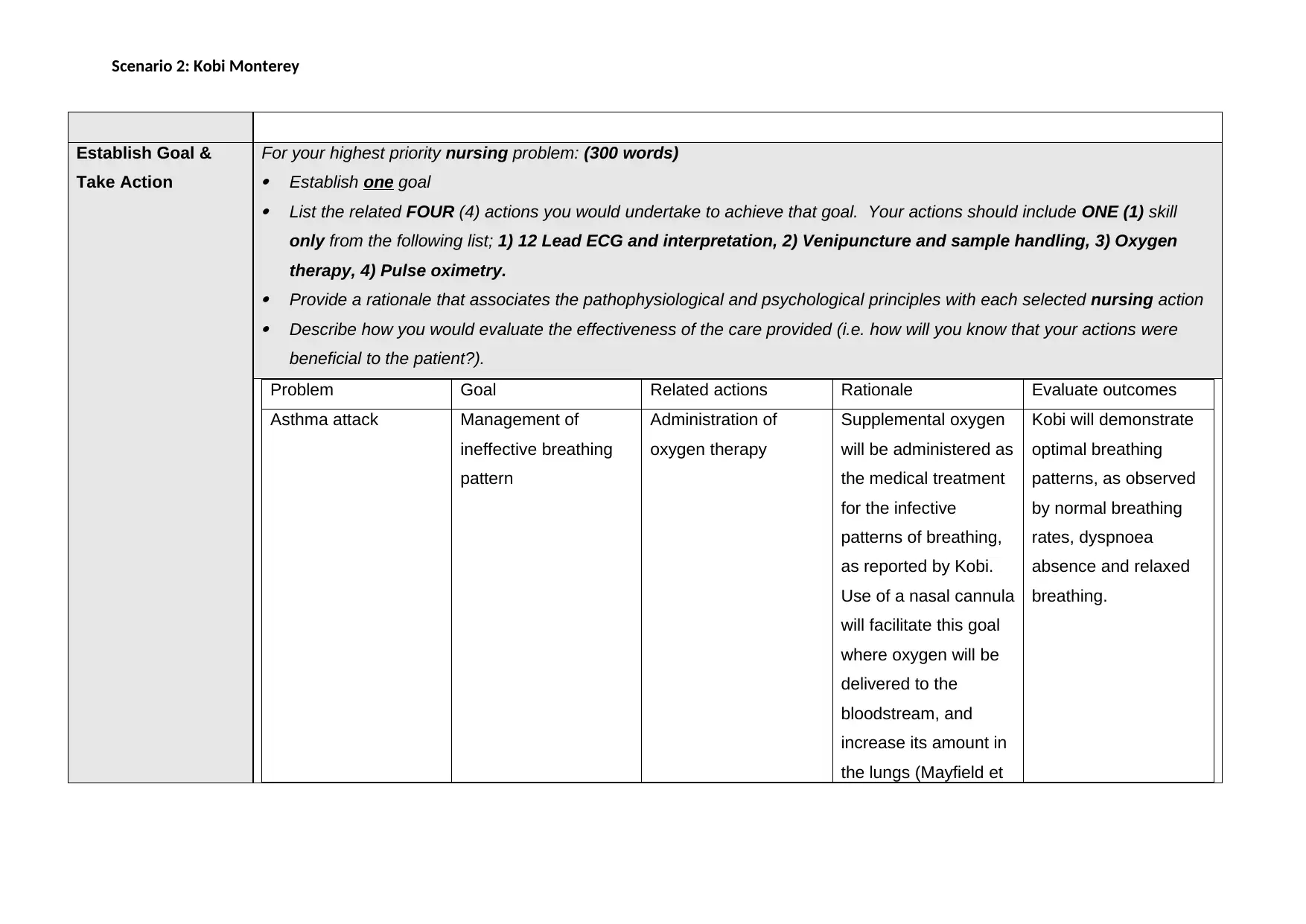
Scenario 2: Kobi Monterey
Establish Goal &
Take Action
For your highest priority nursing problem: (300 words)
Establish one goal
List the related FOUR (4) actions you would undertake to achieve that goal. Your actions should include ONE (1) skill
only from the following list; 1) 12 Lead ECG and interpretation, 2) Venipuncture and sample handling, 3) Oxygen
therapy, 4) Pulse oximetry.
Provide a rationale that associates the pathophysiological and psychological principles with each selected nursing action
Describe how you would evaluate the effectiveness of the care provided (i.e. how will you know that your actions were
beneficial to the patient?).
Problem Goal Related actions Rationale Evaluate outcomes
Asthma attack Management of
ineffective breathing
pattern
Administration of
oxygen therapy
Supplemental oxygen
will be administered as
the medical treatment
for the infective
patterns of breathing,
as reported by Kobi.
Use of a nasal cannula
will facilitate this goal
where oxygen will be
delivered to the
bloodstream, and
increase its amount in
the lungs (Mayfield et
Kobi will demonstrate
optimal breathing
patterns, as observed
by normal breathing
rates, dyspnoea
absence and relaxed
breathing.
Establish Goal &
Take Action
For your highest priority nursing problem: (300 words)
Establish one goal
List the related FOUR (4) actions you would undertake to achieve that goal. Your actions should include ONE (1) skill
only from the following list; 1) 12 Lead ECG and interpretation, 2) Venipuncture and sample handling, 3) Oxygen
therapy, 4) Pulse oximetry.
Provide a rationale that associates the pathophysiological and psychological principles with each selected nursing action
Describe how you would evaluate the effectiveness of the care provided (i.e. how will you know that your actions were
beneficial to the patient?).
Problem Goal Related actions Rationale Evaluate outcomes
Asthma attack Management of
ineffective breathing
pattern
Administration of
oxygen therapy
Supplemental oxygen
will be administered as
the medical treatment
for the infective
patterns of breathing,
as reported by Kobi.
Use of a nasal cannula
will facilitate this goal
where oxygen will be
delivered to the
bloodstream, and
increase its amount in
the lungs (Mayfield et
Kobi will demonstrate
optimal breathing
patterns, as observed
by normal breathing
rates, dyspnoea
absence and relaxed
breathing.
Paraphrase This Document
Need a fresh take? Get an instant paraphrase of this document with our AI Paraphraser
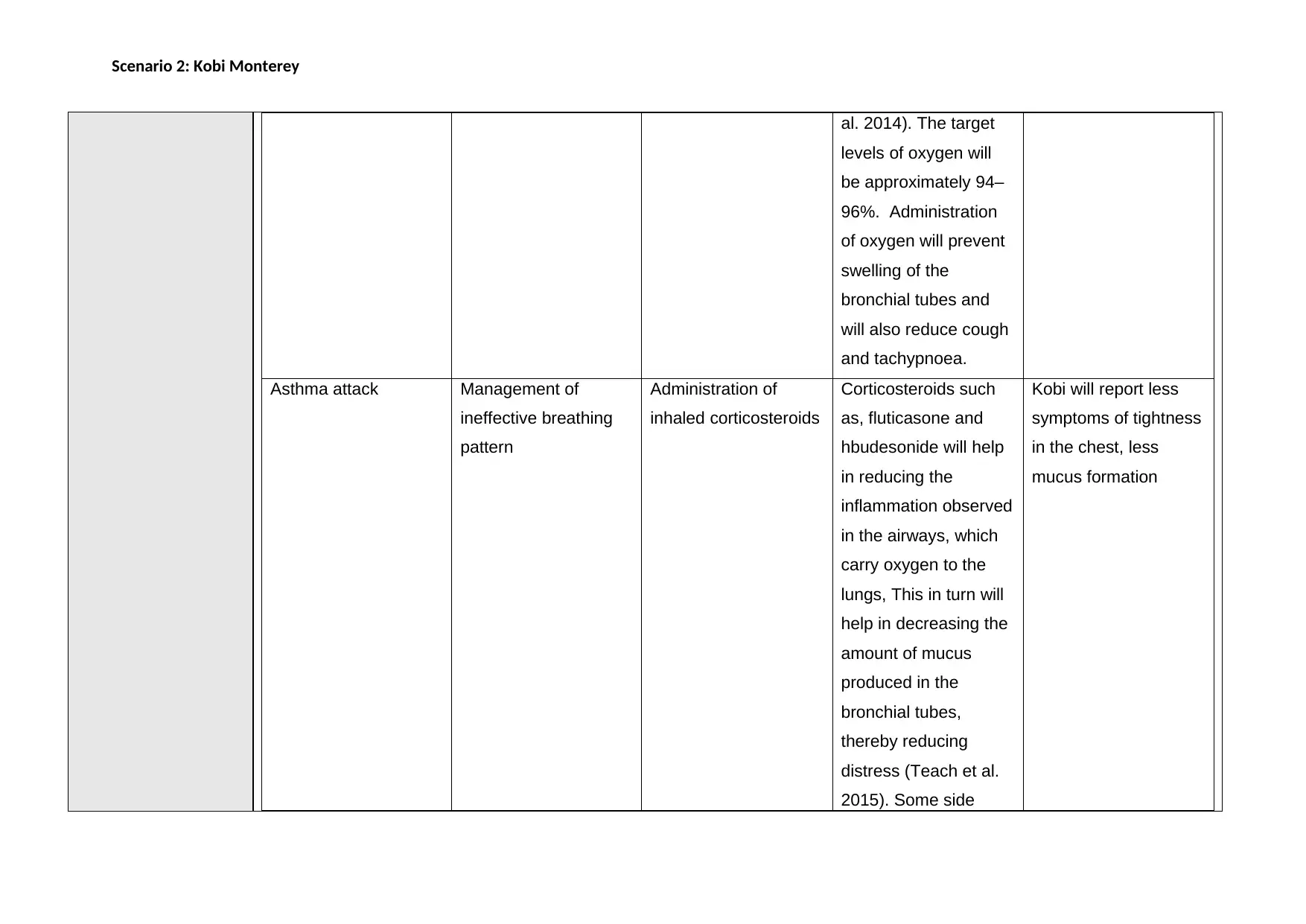
Scenario 2: Kobi Monterey
al. 2014). The target
levels of oxygen will
be approximately 94–
96%. Administration
of oxygen will prevent
swelling of the
bronchial tubes and
will also reduce cough
and tachypnoea.
Asthma attack Management of
ineffective breathing
pattern
Administration of
inhaled corticosteroids
Corticosteroids such
as, fluticasone and
hbudesonide will help
in reducing the
inflammation observed
in the airways, which
carry oxygen to the
lungs, This in turn will
help in decreasing the
amount of mucus
produced in the
bronchial tubes,
thereby reducing
distress (Teach et al.
2015). Some side
Kobi will report less
symptoms of tightness
in the chest, less
mucus formation
al. 2014). The target
levels of oxygen will
be approximately 94–
96%. Administration
of oxygen will prevent
swelling of the
bronchial tubes and
will also reduce cough
and tachypnoea.
Asthma attack Management of
ineffective breathing
pattern
Administration of
inhaled corticosteroids
Corticosteroids such
as, fluticasone and
hbudesonide will help
in reducing the
inflammation observed
in the airways, which
carry oxygen to the
lungs, This in turn will
help in decreasing the
amount of mucus
produced in the
bronchial tubes,
thereby reducing
distress (Teach et al.
2015). Some side
Kobi will report less
symptoms of tightness
in the chest, less
mucus formation
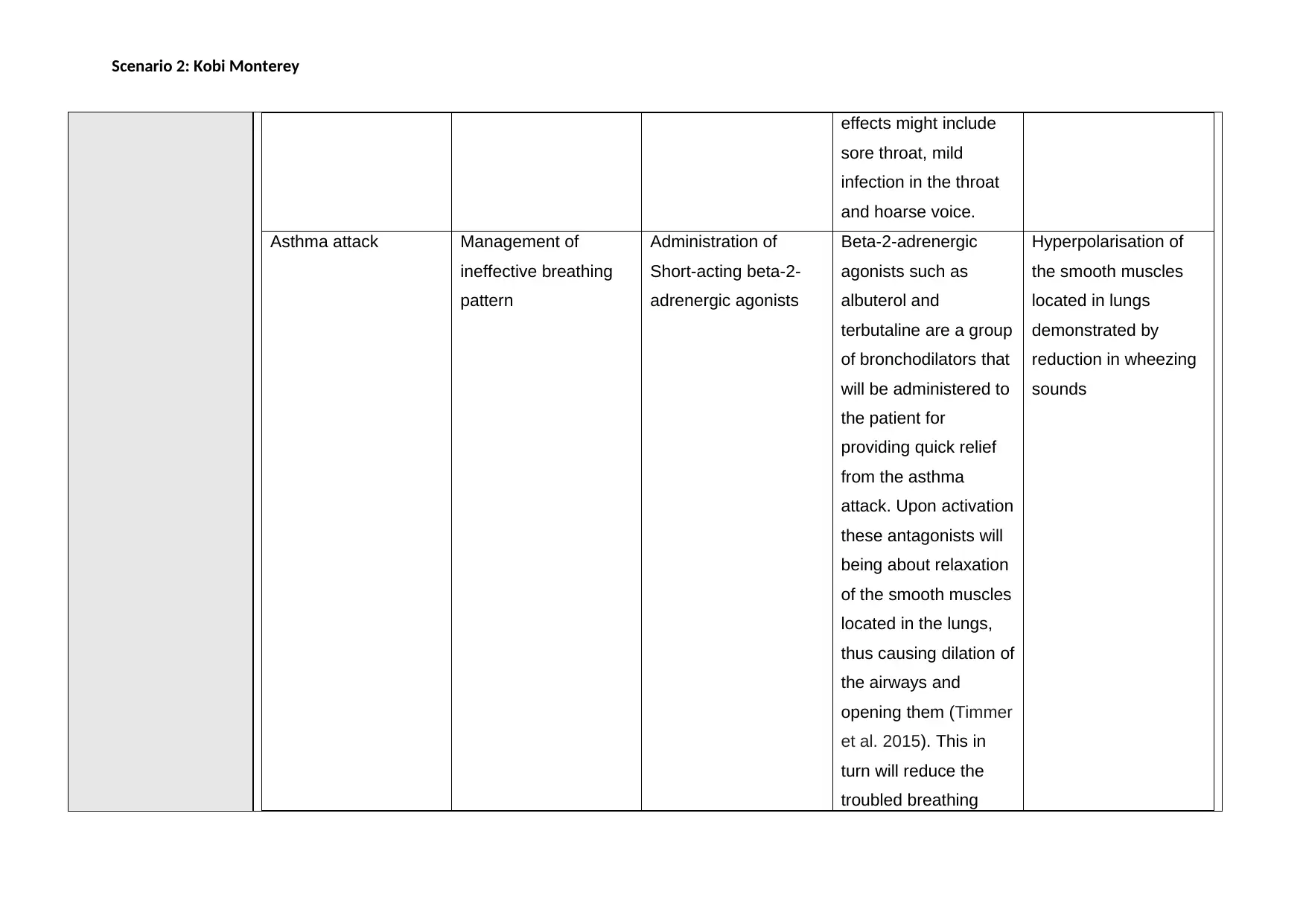
Scenario 2: Kobi Monterey
effects might include
sore throat, mild
infection in the throat
and hoarse voice.
Asthma attack Management of
ineffective breathing
pattern
Administration of
Short-acting beta-2-
adrenergic agonists
Beta-2-adrenergic
agonists such as
albuterol and
terbutaline are a group
of bronchodilators that
will be administered to
the patient for
providing quick relief
from the asthma
attack. Upon activation
these antagonists will
being about relaxation
of the smooth muscles
located in the lungs,
thus causing dilation of
the airways and
opening them (Timmer
et al. 2015). This in
turn will reduce the
troubled breathing
Hyperpolarisation of
the smooth muscles
located in lungs
demonstrated by
reduction in wheezing
sounds
effects might include
sore throat, mild
infection in the throat
and hoarse voice.
Asthma attack Management of
ineffective breathing
pattern
Administration of
Short-acting beta-2-
adrenergic agonists
Beta-2-adrenergic
agonists such as
albuterol and
terbutaline are a group
of bronchodilators that
will be administered to
the patient for
providing quick relief
from the asthma
attack. Upon activation
these antagonists will
being about relaxation
of the smooth muscles
located in the lungs,
thus causing dilation of
the airways and
opening them (Timmer
et al. 2015). This in
turn will reduce the
troubled breathing
Hyperpolarisation of
the smooth muscles
located in lungs
demonstrated by
reduction in wheezing
sounds
⊘ This is a preview!⊘
Do you want full access?
Subscribe today to unlock all pages.

Trusted by 1+ million students worldwide
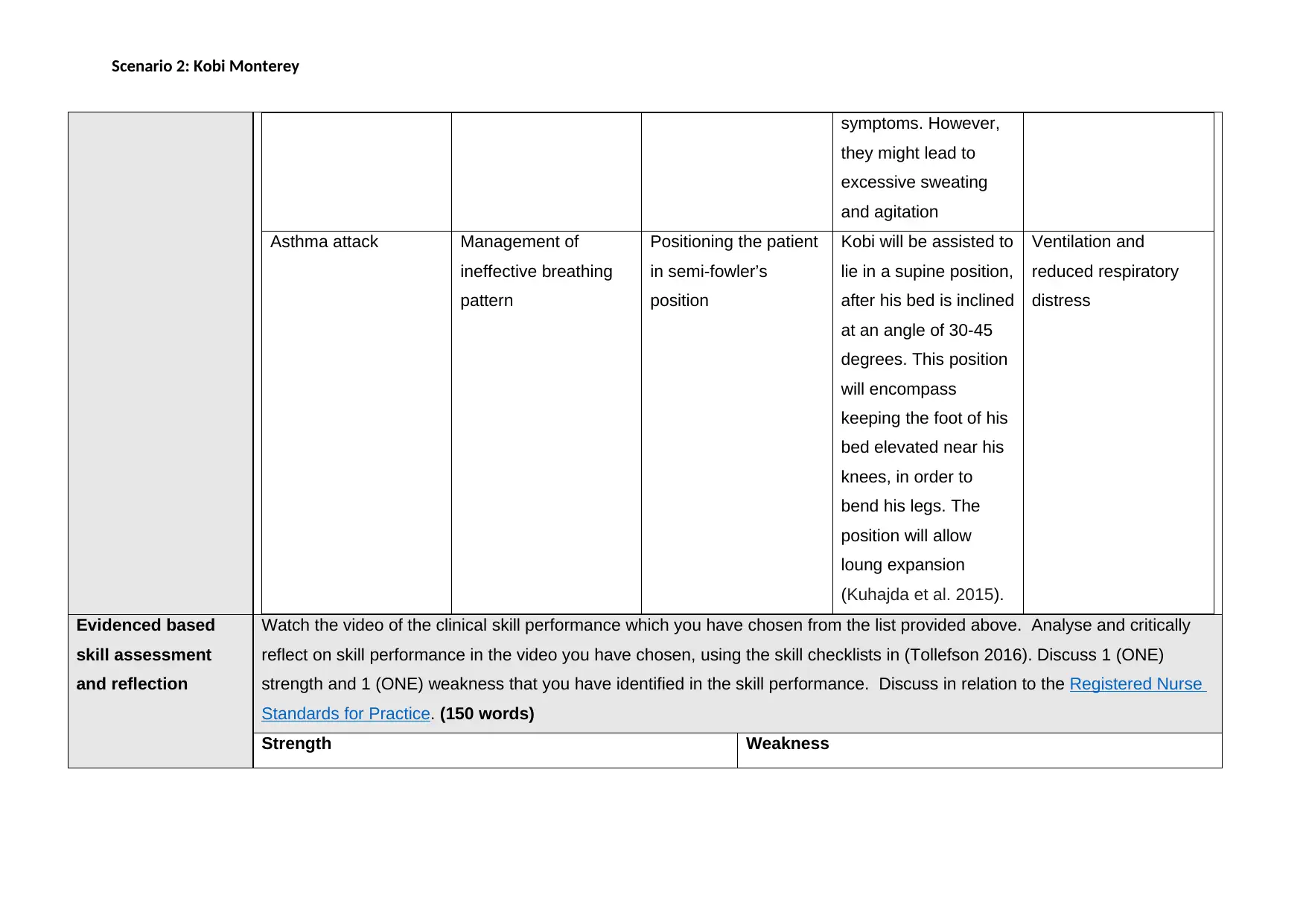
Scenario 2: Kobi Monterey
symptoms. However,
they might lead to
excessive sweating
and agitation
Asthma attack Management of
ineffective breathing
pattern
Positioning the patient
in semi-fowler’s
position
Kobi will be assisted to
lie in a supine position,
after his bed is inclined
at an angle of 30-45
degrees. This position
will encompass
keeping the foot of his
bed elevated near his
knees, in order to
bend his legs. The
position will allow
loung expansion
(Kuhajda et al. 2015).
Ventilation and
reduced respiratory
distress
Evidenced based
skill assessment
and reflection
Watch the video of the clinical skill performance which you have chosen from the list provided above. Analyse and critically
reflect on skill performance in the video you have chosen, using the skill checklists in (Tollefson 2016). Discuss 1 (ONE)
strength and 1 (ONE) weakness that you have identified in the skill performance. Discuss in relation to the Registered Nurse
Standards for Practice. (150 words)
Strength Weakness
symptoms. However,
they might lead to
excessive sweating
and agitation
Asthma attack Management of
ineffective breathing
pattern
Positioning the patient
in semi-fowler’s
position
Kobi will be assisted to
lie in a supine position,
after his bed is inclined
at an angle of 30-45
degrees. This position
will encompass
keeping the foot of his
bed elevated near his
knees, in order to
bend his legs. The
position will allow
loung expansion
(Kuhajda et al. 2015).
Ventilation and
reduced respiratory
distress
Evidenced based
skill assessment
and reflection
Watch the video of the clinical skill performance which you have chosen from the list provided above. Analyse and critically
reflect on skill performance in the video you have chosen, using the skill checklists in (Tollefson 2016). Discuss 1 (ONE)
strength and 1 (ONE) weakness that you have identified in the skill performance. Discuss in relation to the Registered Nurse
Standards for Practice. (150 words)
Strength Weakness
Paraphrase This Document
Need a fresh take? Get an instant paraphrase of this document with our AI Paraphraser
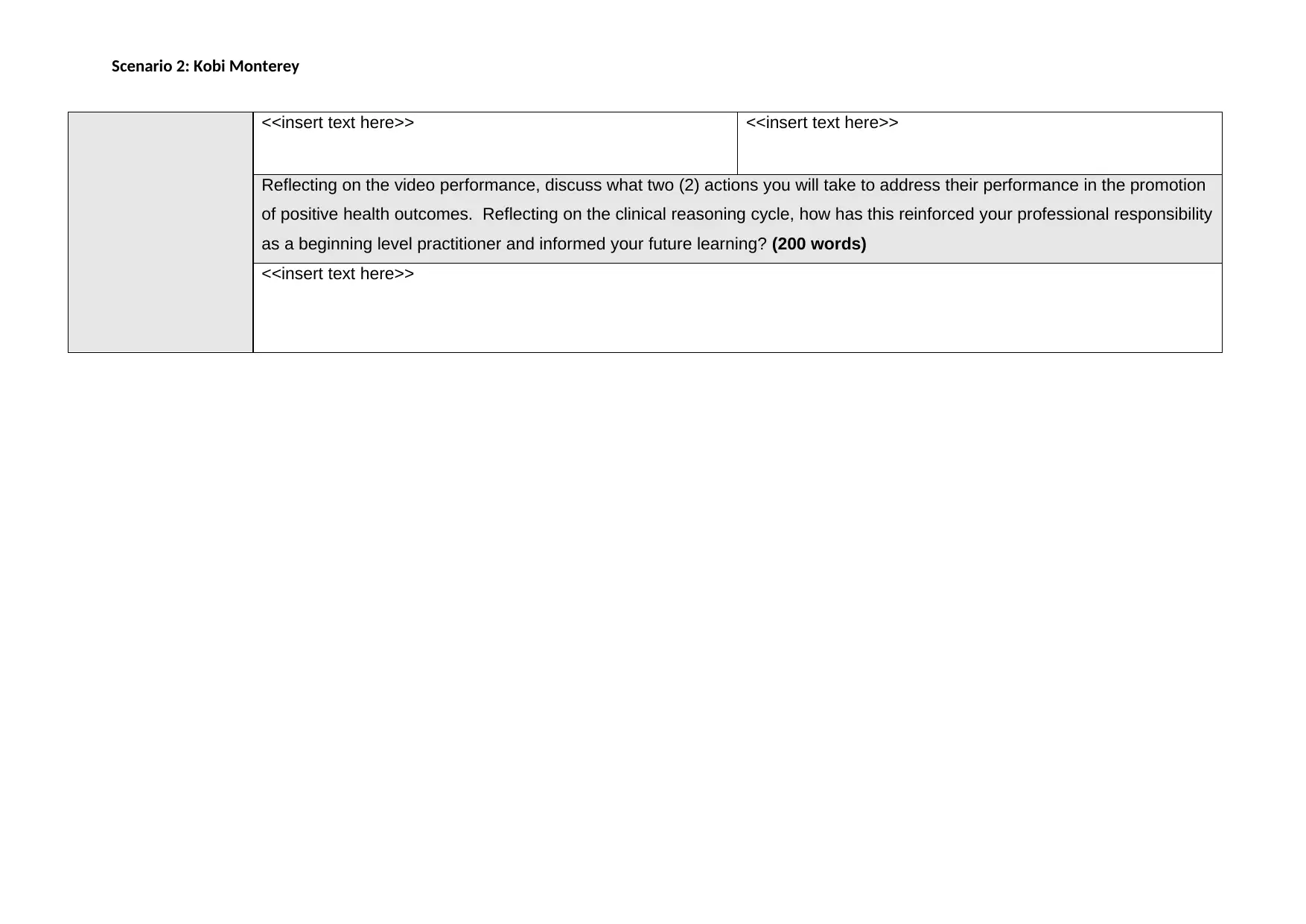
Scenario 2: Kobi Monterey
<<insert text here>> <<insert text here>>
Reflecting on the video performance, discuss what two (2) actions you will take to address their performance in the promotion
of positive health outcomes. Reflecting on the clinical reasoning cycle, how has this reinforced your professional responsibility
as a beginning level practitioner and informed your future learning? (200 words)
<<insert text here>>
<<insert text here>> <<insert text here>>
Reflecting on the video performance, discuss what two (2) actions you will take to address their performance in the promotion
of positive health outcomes. Reflecting on the clinical reasoning cycle, how has this reinforced your professional responsibility
as a beginning level practitioner and informed your future learning? (200 words)
<<insert text here>>
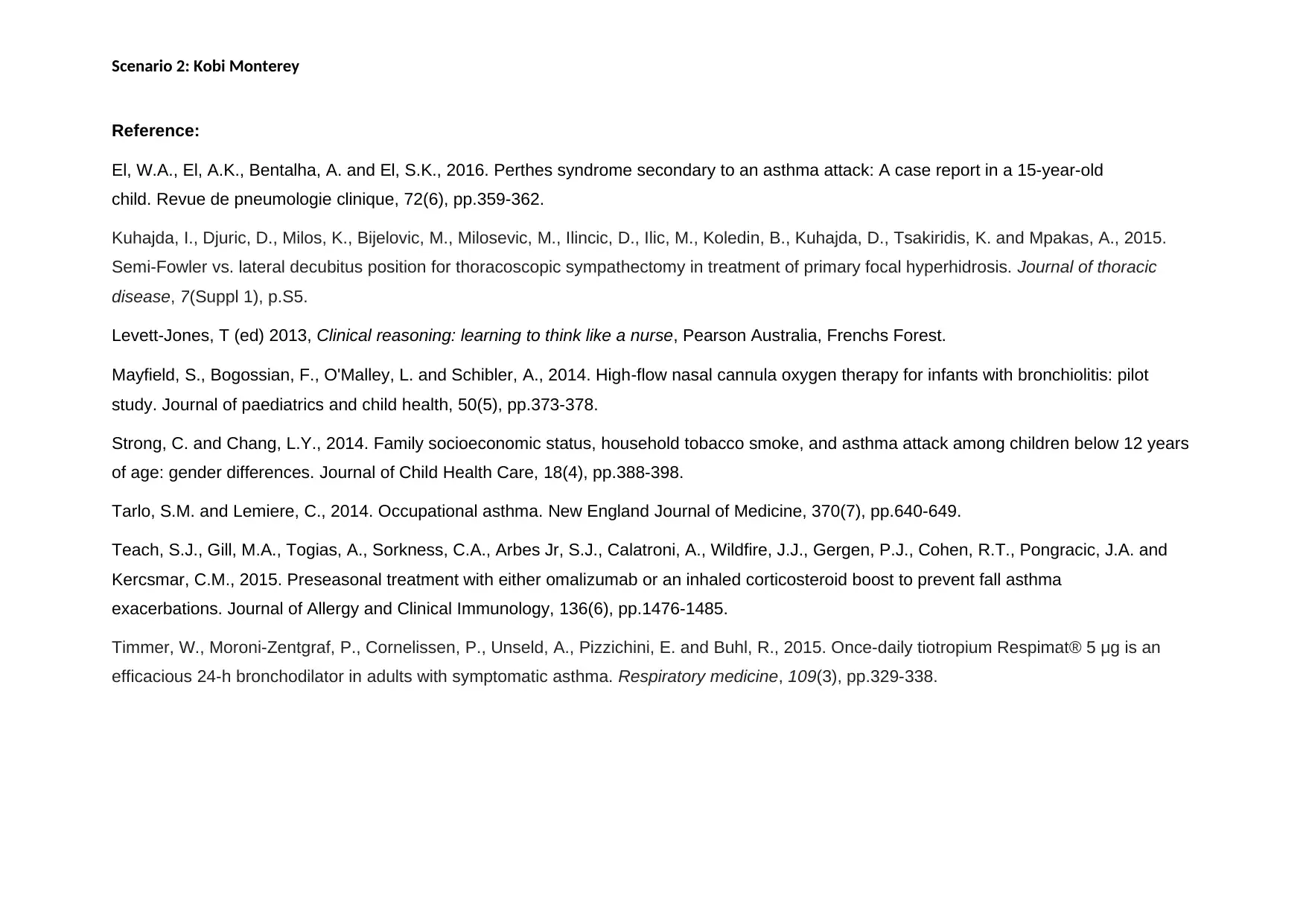
Scenario 2: Kobi Monterey
Reference:
El, W.A., El, A.K., Bentalha, A. and El, S.K., 2016. Perthes syndrome secondary to an asthma attack: A case report in a 15-year-old
child. Revue de pneumologie clinique, 72(6), pp.359-362.
Kuhajda, I., Djuric, D., Milos, K., Bijelovic, M., Milosevic, M., Ilincic, D., Ilic, M., Koledin, B., Kuhajda, D., Tsakiridis, K. and Mpakas, A., 2015.
Semi-Fowler vs. lateral decubitus position for thoracoscopic sympathectomy in treatment of primary focal hyperhidrosis. Journal of thoracic
disease, 7(Suppl 1), p.S5.
Levett-Jones, T (ed) 2013, Clinical reasoning: learning to think like a nurse, Pearson Australia, Frenchs Forest.
Mayfield, S., Bogossian, F., O'Malley, L. and Schibler, A., 2014. High‐flow nasal cannula oxygen therapy for infants with bronchiolitis: pilot
study. Journal of paediatrics and child health, 50(5), pp.373-378.
Strong, C. and Chang, L.Y., 2014. Family socioeconomic status, household tobacco smoke, and asthma attack among children below 12 years
of age: gender differences. Journal of Child Health Care, 18(4), pp.388-398.
Tarlo, S.M. and Lemiere, C., 2014. Occupational asthma. New England Journal of Medicine, 370(7), pp.640-649.
Teach, S.J., Gill, M.A., Togias, A., Sorkness, C.A., Arbes Jr, S.J., Calatroni, A., Wildfire, J.J., Gergen, P.J., Cohen, R.T., Pongracic, J.A. and
Kercsmar, C.M., 2015. Preseasonal treatment with either omalizumab or an inhaled corticosteroid boost to prevent fall asthma
exacerbations. Journal of Allergy and Clinical Immunology, 136(6), pp.1476-1485.
Timmer, W., Moroni-Zentgraf, P., Cornelissen, P., Unseld, A., Pizzichini, E. and Buhl, R., 2015. Once-daily tiotropium Respimat® 5 μg is an
efficacious 24-h bronchodilator in adults with symptomatic asthma. Respiratory medicine, 109(3), pp.329-338.
Reference:
El, W.A., El, A.K., Bentalha, A. and El, S.K., 2016. Perthes syndrome secondary to an asthma attack: A case report in a 15-year-old
child. Revue de pneumologie clinique, 72(6), pp.359-362.
Kuhajda, I., Djuric, D., Milos, K., Bijelovic, M., Milosevic, M., Ilincic, D., Ilic, M., Koledin, B., Kuhajda, D., Tsakiridis, K. and Mpakas, A., 2015.
Semi-Fowler vs. lateral decubitus position for thoracoscopic sympathectomy in treatment of primary focal hyperhidrosis. Journal of thoracic
disease, 7(Suppl 1), p.S5.
Levett-Jones, T (ed) 2013, Clinical reasoning: learning to think like a nurse, Pearson Australia, Frenchs Forest.
Mayfield, S., Bogossian, F., O'Malley, L. and Schibler, A., 2014. High‐flow nasal cannula oxygen therapy for infants with bronchiolitis: pilot
study. Journal of paediatrics and child health, 50(5), pp.373-378.
Strong, C. and Chang, L.Y., 2014. Family socioeconomic status, household tobacco smoke, and asthma attack among children below 12 years
of age: gender differences. Journal of Child Health Care, 18(4), pp.388-398.
Tarlo, S.M. and Lemiere, C., 2014. Occupational asthma. New England Journal of Medicine, 370(7), pp.640-649.
Teach, S.J., Gill, M.A., Togias, A., Sorkness, C.A., Arbes Jr, S.J., Calatroni, A., Wildfire, J.J., Gergen, P.J., Cohen, R.T., Pongracic, J.A. and
Kercsmar, C.M., 2015. Preseasonal treatment with either omalizumab or an inhaled corticosteroid boost to prevent fall asthma
exacerbations. Journal of Allergy and Clinical Immunology, 136(6), pp.1476-1485.
Timmer, W., Moroni-Zentgraf, P., Cornelissen, P., Unseld, A., Pizzichini, E. and Buhl, R., 2015. Once-daily tiotropium Respimat® 5 μg is an
efficacious 24-h bronchodilator in adults with symptomatic asthma. Respiratory medicine, 109(3), pp.329-338.
⊘ This is a preview!⊘
Do you want full access?
Subscribe today to unlock all pages.

Trusted by 1+ million students worldwide
1 out of 9
Related Documents
Your All-in-One AI-Powered Toolkit for Academic Success.
+13062052269
info@desklib.com
Available 24*7 on WhatsApp / Email
![[object Object]](/_next/static/media/star-bottom.7253800d.svg)
Unlock your academic potential
Copyright © 2020–2025 A2Z Services. All Rights Reserved. Developed and managed by ZUCOL.





